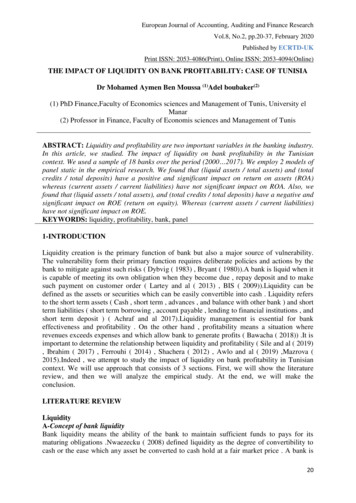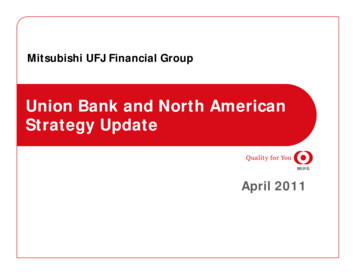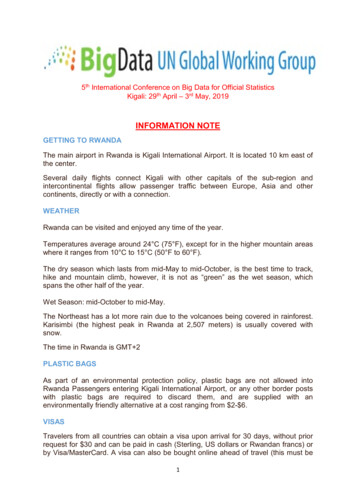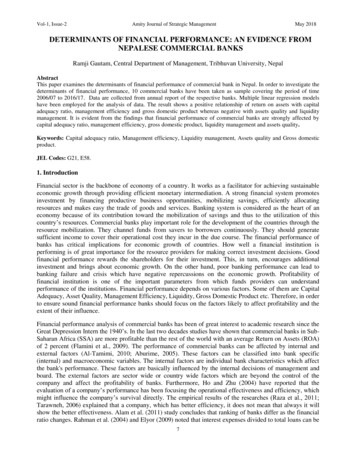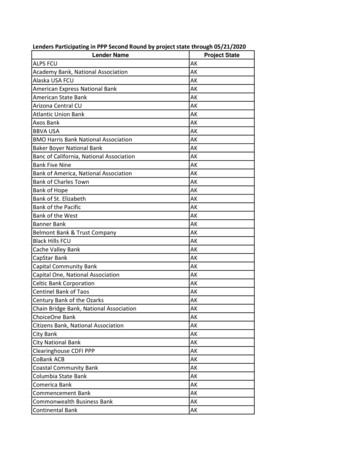
Transcription
Munich Personal RePEc ArchiveDETERMINANTS OF BANKPROFITABILITY IN THE SOUTHEASTERN EUROPEAN REGIONAthanasoglou, Panayiotis and Delis, Manthos andStaikouras, Christos2006Online at https://mpra.ub.uni-muenchen.de/10274/MPRA Paper No. 10274, posted 20 Sep 2008 04:31 UTC
DETERMINANTS OF BANK PROFITABILITY IN THE SOUTHEASTERN EUROPEAN REGIONPanayiotis P. AthanasoglouBank of GreeceMatthaios D. DelisAthens University of Economics and BusinessChristos K. StaikourasAthens University of Economics and BusinessABSTRACTThe aim of this study is to examine the profitability behaviour of bank-specific, industryrelated and macroeconomic determinants, using an unbalanced panel dataset of SouthEastern European (SEE) credit institutions over the period 1998-2002. The estimationresults indicate that, with the exception of liquidity, all bank-specific determinantssignificantly affect bank profitability in the anticipated way. A key result is that the effectof concentration is positive, which provides evidence in support of the structure-conductperformance hypothesis, even though some ambiguity arises given its interrelationshipwith the efficient-structure hypothesis. In contrast, a positive relationship betweenbanking reform and profitability was not identified, whilst the picture regarding themacroeconomic determinants is mixed. The paper concludes with some remarks on thepracticality and implementability of the findings.Keywords: Bank profitability; South Eastern European banking sector; Random effectsJEL Classification: G21; C23; L2Acknowledgements: The authors would like to thank I. Asimakopoulos, E. Georgiou, H. Gibson and D.Kosma for very helpful comments. The views expressed in this paper do not necessarily reflect those of theBank of Greece.1
1. IntroductionThe financial system of the South Eastern European (SEE) countries ischaracterised by the dominant role of the banking sector, with the capital market segmentfor long-term finance being illiquid and, in some cases, underdeveloped, while non-bankfinancial intermediaries, such as life insurance companies and private pension funds, arestill at an embryonic stage of development (European Commission [EC], 2004). Yet, therecent reforms, aiming to liberalize and consolidate the existing banks, as well as toattract foreign ones in the SEE banking sector, were, to a large extent, quite successful.As a result, the legal, institutional, regulatory, and supervisory framework of financialinstitutions has been consistently improved and strengthened. These remarks explain whybanking activities and performance have attracted the attention of practitioners, policymakers, and researchers alike, making the investigation of bank profitability in the SEEcountries a more relevant issue today than in earlier times.This paper seeks to examine the effect of bank-specific, industry-related andmacroeconomic variables on the profitability of the SEE banking industry (namelyAlbania, Bosnia-Herzegovina, Bulgaria, Croatia, FYROM, Romania and SerbiaMontenegro) over the period 1998-2002. It focuses on two main directions: Firstly, whilea number of studies have examined the effects of internal and external factors on bankprofitability in several countries and geographic regions, as far as we are aware of, hardlyany systematic research has been carried out for the rapidly evolving SEE region; andsecondly, while distinguishing between the structure-conduct-performance (SCP) and theefficient-structure (EFS) hypotheses, we also account for the effect of the reform process,that took place during this period, and the macroeconomic environment on profitability.The rest of the paper is organized as follows. Section 2 reviews and evaluates thereform process observed in the SEE banking sector over the last decade. Section 3provides a background of the existing literature, relating bank profitability to itsdeterminants. Section 4 describes the data and the econometric methodology, whileSection 5 presents and analyses the empirical results. Conclusions and some policysuggestions are offered in the final section.2
2. Banking reform in the SEE countriesEven though banking system restructuring was quite profound over the lastdecade in most SEE countries, there is still much to be done for their financial systems tobe classified in the category of developed markets. The comparison of the developmentof the banking sector (measured by the credit to the private sector as a percentage ofGDP) with the size of the capital market (measured by the stock market capitalization asa percentage of GDP) in the SEE countries reveals the relative importance of bankintermediation. 1 As it appears, from a first glimpse, banks constitute the spinal cord offinancial systems in the region.Despite faster development in the second half of the 1990s, when relatively stablefinancial and macroeconomic conditions emerged, the quantity and quality of bankingproducts and services still lag behind that of other emerging markets and the EuropeanUnion (EU). This occurs mainly due to the unsound macroeconomic policies applied inthe region and the market inefficiencies observed in the SEE countries in the previousdecades, factors that, in many cases, resulted in severe crises.2 As a result, loans to theprivate sector, on average, stood at about one-eighth of the credit provided by the euroarea banking system, where domestic credit reached 120 per cent of GDP in 2002(European Central Bank [ECB], 2004). This implies that the banking sector in the SEEcountries, in spite of the recent expansion, has still ample field for further financing theeconomies’ investment and growth needs, if macroeconomic and institutional stability isenhanced.During the last few years, the governments of the SEE countries, with thecollaboration and assistance of international financial institutions, have taken concreteand far-reaching measures to reform their financial institutions and markets. This process1Considering two of the largest economies in the SEE region in 2002, namely Croatia and Bulgaria, creditto the private sector was 44 per cent and 18 per cent of GDP, respectively, while stock market capitalizationwas 16 per cent and 4 per cent of GDP, respectively (European Bank for Reconstruction and Development[EBRD], 2004). In Romania, the only exception to the dominance of banks, domestic credit to the privatesector stood at 8 per cent of GDP in 2002, while stock market capitalization was at 10 per cent of GDP.2These crises include the strong economic shock that hit FYROM in the first half of 1999, thehyperinflation and hostility in Serbia-Montenegro during the previous decade, the political instability inBosnia-Herzegovina in the same time period, the collapse of the pyramid scheme in Albania in 1996-97,the crisis in Romania in 1997-98 and the severe crisis in Bulgaria in 1996-97 (one of the world’s worstbanking crises in recent history, when 14 out of the 35 commercial banks failed).3
included the restructuring, rehabilitation and privatisation of state-owned banks, theliquidation of insolvent institutions and an improvement in the administrative efficiencyand capability of the banking sector. Other factors that enhanced banking intermediationwere the establishment of new prudential regulation and tighter supervision, animprovement of accounting and disclosure standards, the adoption of better techniquesfor risk evaluation and asset and liability management and, last but not least, theinvolvement of foreign investors.Table 1 provides a comprehensive chronological account of important regulatoryevents with references to the most important banking legislation - as well as theiramendments - enacted during the last decade. These laws have increased theattractiveness of the SEE banking system for foreign investment, strengthened prudentstandards and practices in the banks’ operations, enhanced corporate governance, andimproved efficiency in the banking operations and supervision. Deposit insuranceschemes have also played an important stabilizing role, as they improved confidence andthereby decreased the risks for swift changes in funding, i.e. the deposit base.Finally, macroeconomic factors, such as fiscal and monetary discipline, thegradual reduction of interest rates and risk premiums, the rise of expected lifetime incomein the region and an increasing money demand have all positively contributed to thedevelopment of financial markets. These developments enhanced the ongoing rise andbroadening of intermediation in the SEE region. As a result, the structure of the bankingindustry in the SEE economies altered significantly during the period 1998-2002. Table 2reports a decline in the number of banks operating in all countries reviewed, except fromAlbania and Bulgaria. This decline is quite substantial in Bosnia-Herzegovina and SerbiaMontenegro. 3 Especially in the latter case, less than half of the banks survived during theperiod examined (50 banks in 2002 compared with 104 in 1998), due to the closure ofunsound financial institutions and the consolidation of smaller banks initiated in 2000.The reduction in the number of credit institutions in most SEE countries was fuelledlargely by increased regulatory capitalization requirements (a policy aimed at bringing3Serbia has the largest number of banks in the SEE region, reflecting the relatively larger size of theSerbian population and economy, as well as a more fragmented sector compared to the other SEE countries.4
the banking sector closer to the EU capital adequacy and liquidity standards) andcompetition from foreign banks (EC, 2004).3. Literature reviewIn the literature, bank profitability, typically measured by the return on assets(ROA) and/or the return on equity (ROE), is usually expressed as a function of internaland external determinants. Internal determinants are factors that are mainly influenced bya bank’s management decisions and policy objectives. Such profitability determinants arethe level of liquidity, provisioning policy, capital adequacy, expenses management andbank size. On the other hand, the external determinants, both industry-related andmacroeconomic, are variables that reflect the economic and legal environment where thecredit institution operates.Liquidity risk, arising from the possible inability of a bank to accommodatedecreases in liabilities or to fund increases on the assets’ side of the balance sheet, isconsidered an important determinant of bank profitability. The loans market, especiallycredit to households and firms, is risky and has a greater expected return than other bankassets, such as government securities. Thus, one would expect a positive relationshipbetween liquidity and profitability (Bourke, 1989). It could be the case, however, that thefewer the funds tide up in liquid investments the higher we might expect profitability tobe (Eichengreen and Gibson, 2001).Changes in credit risk may reflect changes in the health of a bank’s loan portfolio(see Cooper et al., 2003), which may affect the performance of the institution. Duca andMcLaughlin (1990), among others, conclude that variations in bank profitability arelargely attributable to variations in credit risk, since increased exposure to credit risk isnormally associated with decreased firm profitability. This triggers a discussionconcerning not the volume but the quality of loans made. In this direction, Miller andNoulas (1997) suggest that the more financial institutions are exposed to high-risk loans,the higher the accumulation of unpaid loans and the lower the profitability.5
Even though leverage (overall capitalization) has been demonstrated to beimportant in explaining the performance of financial institutions, its impact on bankprofitability is ambiguous. As lower capital ratios suggest a relatively risky position, onewould expect a negative coefficient on this variable (for a thorough discussion seeBerger, 1995b). However, it could be the case that higher levels of equity would decreasethe cost of capital, leading to a positive impact on profitability (Molyneux, 1993).Moreover, an increase in capital may raise expected earnings by reducing the expectedcosts of financial distress, including bankruptcy (Berger, 1995b). Indeed, most studiesthat use capital ratios as an explanatory variable of bank profitability (e.g. Bourke, 1989;Molyneux and Thornton; 1992; Goddard et al., 2004) observe a positive relationship.Finally, Athanasoglou et al. (2005), suggest that capital is better modelled as anendogenous determinant of bank profitability, as higher profits may lead to an increase incapital (also see Berger, 1995b).For the most part, the literature argues that reduced expenses improve theefficiency and hence raise the profitability of a financial institution, implying a negativerelationship between an operating expenses ratio and profitability (Bourke, 1989).However, Molyneux and Thornton (1992) observed a positive relationship, suggestingthat high profits earned by firms may be appropriated in the form of higher payrollexpenditures paid to more productive human capital. 4 In any case, it should be appealingto identify the dominant effect, in a highly transitional banking environment like theSEE’s.Bank size is generally used to capture potential economies or diseconomies ofscale in the banking sector. This variable controls for cost differences and product andrisk diversification according to the size of the credit institution. The first factor couldlead to a positive relationship between size and bank profitability, if there are significanteconomies of scale (see Akhavein et al. 1997; Bourke, 1989; Molyneux and Thornton,1992; Bikker and Hu, 2002; Goddard et al., 2004), while the second to a negative one, ifincreased diversification leads to lower credit risk and thus lower returns. Other4A guess would be that such a relationship is observed in developed banking systems, which hire highquality and, therefore, relatively high cost staff. Hence, providing that the high quality staff is sufficientlyproductive, such banks will not be disadvantaged from a relative efficiency point of view.6
researchers, however, conclude that few cost savings can be achieved by increasing thesize of a banking firm, especially as markets develop (Berger et al., 1987; Boyd andRunkle, 1993; Miller and Noulas, 1997; Athanasoglou et al., 2005). Eichengreen andGibson (2001), suggest that the effect of a growing bank’s size on profitability may bepositive up to a certain limit. Beyond this point the effect of size could be negative due tobureaucratic and other reasons. Hence, the size-profitability relationship may be expectedto be non-linear.In Section 2, we suggested that the new regulatory framework in the SEEcountries significantly increased the attractiveness of its banking system for foreigninvestors. In the period under consideration there was a notable entry of foreign banks,which were looking for acquisition opportunities in the promising – yet underdeveloped –SEE banking system. Foreign ownership may have an impact on bank profitability due toa number of reasons: First, the capital brought in by foreign investors decrease fiscalcosts of banks’ restructuring (Tang et al., 2000). Second, foreign banks may bringexpertise in risk management and a better culture of corporate governance, renderingbanks more efficient (Bonin et al., 2005). Third, foreign bank presence increasescompetition, driving domestic banks to cut costs and improve efficiency (Claessens et al.,2001). Finally, domestic banks have benefited from technological spillovers broughtabout by their foreign competitors. For these reasons, an examination of the impact offoreign ownership on the profitability of SEE banks is a useful exercise.The literature concentrating on the relationship between competition andperformance in the banking sector includes the structural and the non-structuralapproaches (for a recent overview of this literature see Berger et al., 2004). The structuralapproaches embrace the structure-conduct-performance (SCP) hypothesis and theefficient structure (EFS) hypothesis. These hypotheses investigate, respectively, whethera highly concentrated market causes collusive behaviour among the larger banks,resulting in superior market performance, and whether it is the efficiency of larger banksthat enhances their performance. On the other hand, the non-structural approaches, whicharose from the developments in the new empirical industrial organization (NEIO)7
literature, 5 test competition through the use of market power, thus stressing the analysisof banks’ competitive conduct in the absence of structural measures.The SCP hypothesis, which has been partly backed up theoretically within thecontext of the NEIO literature by Bikker and Bos (2005), asserts that banks are able toextract monopolistic rents in concentrated markets by their ability to offer lower depositrates and to charge higher loan rates, as a result of collusion or other forms of noncompetitive behaviour. The more concentrated the market, the less the degree ofcompetition. The smaller the number of firms and the more concentrated the marketstructure, the greater is the probability that firms in the market will achieve a joint priceoutput configuration that approaches the monopoly solution. Thus, firms in moreconcentrated markets will earn higher profits (for collusive or monopolistic reasons) thanfirms operating in less concentrated ones, irrespective of their efficiency. Yet, the EFShypothesis posits that concentration may reflect firm-specific efficiencies (see Berger,1995a). Since more efficient firms may be expected to capture a higher market share, oneway of distinguishing between the market power and efficient structure theories is toinclude both market share and concentration in the profitability equation (Eichengreenand Gibson, 2001). If concentration then becomes insignificant, this goes against the SCPhypothesis. 6The literature lacks formal verification of the effect of deregulation on bankprofitability, which might be essential for banking industries undergoing majorrestructuring. Some dated evidence, since the issue does not concern developed bankingsystems (e.g. Edwards, 1977), suggests that deregulation reduces the number of creditinstitutions, while increasing their size. However, as discussed above, the direction ofsuch an effect is unclear; thus far it is not possible to determine whether changes in theintensity of regulation strengthen or weaken performance. Moreover, the contestable5The NEIO literature was pioneered by Iwata (1974), and strongly enhanced by Bresnahan (1982 and1989) and Panzar and Rosse (1987).6The validity of the SCP and the EFS hypotheses have frequently been tested for banking industry andprovide policy makers measures of market structure - either concentration or market share - andperformance as well as their interrelationship (see Gilbert, 1984; Bourke, 1989; Hannan, 1991; Molyneuxand Thornton, 1992; Molyneux, 1993; Lloyd-Williams et al., 1994; Eichengreen and Gibson, 2001).8
market theory, 7 and regulation theory in general, point out the importance of entrybarriers in enhancing profitability, while some other regulatory interventions may have anopposite effect. Mamatzakis et al. (2005) provide evidence that a non-collusive behaviouramong banks is in operation in the SEE banking industry, suggesting the existence of acontestable market. For example, entry restrictions are supported as being necessary forthe prevention of ruinous competition, unsafe and unsound banking practices, and bankfailures. In contrast, other studies on transition countries have highlighted the fact that thefinancial reform process positively affects banks’ profitability and that banking sectorreform is a necessary condition for the development and deepening of the sector (Friesand Taci, 2002).Bank profitability is sensitive to macroeconomic conditions despite the trend inthe industry towards greater geographic diversification and larger use of financialengineering techniques to manage risk associated with business cycle forecasting.Generally, higher economic growth encourages banks to lend more and permits them tocharge higher margins, as well as improving the quality of their assets. Neely andWheelock (1997) use per capita income and suggest that this variable exerts a strongpositive effect on bank earnings. Demirguc-Kunt and Huizinga (2000) and Bikker and Hu(2002) attempted to identify possible cyclical movements in bank profitability - the extentto which bank profits are correlated with the business cycle. 8 Their findings suggest thatsuch correlation exists, although the variables used were not direct measures of thebusiness cycle. A direct measure of the business cycle, namely cyclical output, was usedby Athanasoglou et al. (2005) for the Greek banking industry.A widely used proxy for the effect of the macroeconomic environment on bankprofitability is inflation. Revell (1979) introduces the issue, noting that the effect ofinflation depends on whether banks’ wages and other operating expenses increase at afaster rate than inflation. The question is how mature an economy is so that futureinflation can be accurately forecast and thus banks can accordingly manage their7In a contestable market active firms are vulnerable to “hit and run” entry. For its existence, sunk costsmust be largely absent. In the banking industry, some argue that most of the costs are fixed but not sunk,making it contestable (see Whalen, 1988).9
operating costs. As such, the relationship between the inflation rate and profitability isambiguous and depends on whether or not inflation is anticipated. An inflation rate fullyanticipated by the bank’s management implies that banks can appropriately adjust interestrates in order to increase their revenues faster than their costs and thus acquire higherprofits. On the contrary, unanticipated inflation could lead to improper adjustment ofinterest rates and hence to the possibility that costs could increase faster than revenues.Most studies (e.g. Bourke, 1989; Molyneux and Thornton, 1992) observe a positiverelationship between inflation and bank performance.4. Data and determinants of bank profitability in the SEE regionWe use annual bank level and macroeconomic data from seven SEE countries(Albania, Bosnia-Herzegovina, Bulgaria, Croatia, FYROM, Romania and SerbiaMontenegro) over the period 1998-2002. 9 The bank variables are obtained from theBankScope database, the macroeconomic variables (including inflation and per capitaincome) from the IMF’s International Financial Statistics (IFS) and the banking reformindex from the European Bank for Reconstruction and Development (EBRD). Thedataset is unbalanced, it was reviewed for reporting errors and other inconsistencies and itcovers approximately 80% of the industry’s total assets (including 71 banks in 1998, 91in 1999, 107 in 2000, 121 in 2001 and 132 in 2002).Table 3 lists the variables used to proxy profitability and its determinants (we alsoinclude notation and the expected effect of the determinants according to the literature),and Table 4 presents country averages. In choosing the proxies for bank profitability,namely ROA and ROE, we follow the literature, and we measure both as running yearaverages. 10 For the whole region the period average ROA stands at 1.2 per cent, while theaverage ROE is 8.8 per cent.8Demirguc-Kunt and Huizinga (2000) used the annual growth rate of GDP and GNP per capita to identifysuch a relationship, while Bikker and Hu (2002) used a number of macroeconomic variables (such as GDP,the unemployment rate and interest rate differentials).9We restrict the analysis to commercial and savings banks.10For an analysis on the differences between ROA and ROE, see Athanasoglou et al. (2005).10
4.1 Bank-specific determinantsThe ratio of loans to assets (LA), serving as a proxy for liquidity, stands at anaverage of 42 per cent over the examined period, which is quite lower than the Europeanaverage (ECB, 2004). A better proxy for liquidity would be the ratio of liquid assets tototal assets, however data is unavailable. Another alternative is the ratio of loans todeposits, which has the major disadvantage that it indicates nothing about the liquidity ofthe bank’s remaining assets or the nature of its other liabilities.Regarding credit risk we use the average loan loss provisions to total loans ratio(LLP), which is close to 4 per cent in the region. The poor quality of the stock of creditwas inherited from the old regime, where credit risk evaluation was negligible, and creditpolicy was used as an instrument by the government to fit the needs of the centrallyplanned economy (Stubos and Tsikripis, 2005). Despite the improvement observed overthe period examined in the loan portfolio quality, the LLP ratio is still much higher in theregion relatively to the European one.Similarly, the average equity to assets ratio (EA), widely used in the empiricalresearch as the key capital ratio, is about 17 per cent, much higher than the Europeanaverage (even though it varies significantly across countries). The reasons behind this lowfinancial leverage exploited in the region are the ongoing restructuring process of stateowned financial institutions, the relatively low credit expansion and banks’ compensationfor the poor access to other sources of funds. Although the high ratio might be reassuringfrom the point of sound financial management, it also confirms the existence of a highrisk level in lending operations and the high degree of liquidity and non-banking items onbanks’ balance sheets.The overheads efficiency ratio (OEA), i.e. the ratio of operating expenses to totalassets, is the best proxy for the average cost of non-financial inputs to banks (Fries andTaci, 2005). Operating expenses consist of staff expenses, which comprise salaries andother employee benefits (including transfers to pension reserves and administrative11
expenses). 11 On average, this ratio stands at 5.4 per cent in the SEE region, much higherthan the respective one observed in the EU (1.7 per cent in 2002; see Organisation forEconomic Cooperation and Development [OECD], 2003). Over the period examined, theratio of operating expenses to total assets exhibits a downward trend.We use real banks’ assets (logarithm) to capture the possible relationship betweenbank size (S) and profitability and their square in order to capture the possible non-linearrelationship. Clearly, the average bank size in Albania and Croatia is the largest amongthe SEE countries, while the smallest one is that of FYROM. Overall, the banking sectorincludes small financial institutions with limited country coverage.The relationship between foreign ownership and profitability is examined throughthe inclusion in the model of a binary dummy variable for foreign banks (Dfo), as well asinteraction dummies between ownership and bank characteristics (liquidity, capitalizationand risk). The interaction dummies are included to examine whether some variables havea different impact on foreign and domestic banks. Although the ownership information isoften incomplete, we are able to determine the nature of the controlling interest invirtually all cases. However, we are unable to consider changes of ownership during thesample period because the BankScope database provides ownership information for onlyone year (the same strategy is followed by Bonin et al., 2005).4.2 Industry-related determinantsRegarding the industry-related variables, the SEE banking sector is, on average,characterised by relatively high concentration, much higher than that observed in otherEuropean markets (ECB, 2004). In Table 4 we report the 3-firm concentration ratio (CR3)and the Herfindahl-Hirschman Index (HHI) 12 based on balance sheet aggregates, bothcalculated on the basis of the present sample; the average HHI stands at 2,141 in the SEEbanking region. 13 The banking concentration ratio seems to decline in all SEE countries11Administrative expenses include various types of bank expenses associated with bank operations, such asthe adoption of new information technology, depreciation, legal fees, marketing expenses, or non-recurringcosts related to bank restructuring. Provisions for loans losses are not included in operating expenses.12The HHI is calculated as the sum of the squared market shares in total assets of the individual banks.Note that the index is calculated on a county-specific basis.13The recent literature tends to suggest application of market power measures, estimated using nonstructural approaches. We looked into these approaches but lack of data regarding bank inputs (and12
during the period 1998-2002, in spite of the fact that the number of banks is reduced inmost of the SEE countries. 14 As discussed above the market share (MS) of individualbanks is also included in order to distinguish between the SCP and the EFS hypotheses,again measured on the basis of country-specific subsamples.In this paper, we introduce the EBRD index of banking system reform in the SEEcountries to identify the progress in areas such as: i) the adoption of regulations accordingto international standards and practices, ii) the implementation of higher and moreefficient supervision, iii) the privatisation of state-owned banks and iv) the write-off ofnon-performing loans and the closure of insolvent banks. This index provides a rankingof progress for liberalization and institutional reform of the banking sector, on a scale of1 to 4 . A score of 1 represents little change from a socialist banking system apart fromthe separation of the central bank and commercial banks, while a score of 4 represents alevel of reform that approximates the institutional standards and norms of anindustrialized market economy. On the basis of this index, SEE countries get an averagescore around 2.8 in 2002, most of them c
The aim of this study is to examine the profitability behaviour of bank-specific, industry-related and macroeconomic determinants, using an unbalanced panel dataset of South Eastern European (SEE) credit institutions over the period 1998-2002. The estimation results indicate that, with the exception of liquidity, all bank-specific determinants




